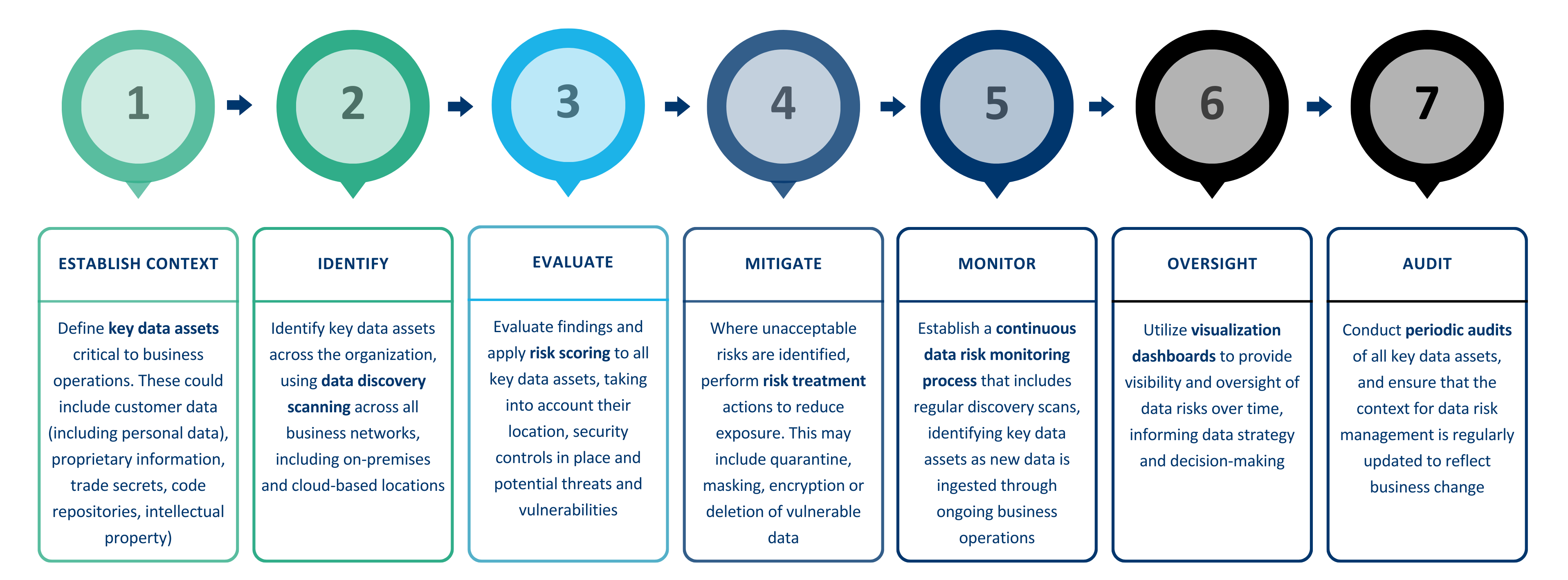Data risk management is becoming increasingly important to businesses, as the vast amounts of data generated today present potential both for operational gain and organizational risk.
Over the last decade, data has emerged as the lifeblood of innovation. Nevertheless, handling such vast quantities of data, much of which is personal or commercially sensitive, comes with inherent risks. These include data breaches, privacy violations and regulatory non-compliance, which can have severe and costly consequences for organizations.
In this article, we’ll explain the seven steps you can take to effective data risk management for your organization.
The importance of data risk management
Regulatory and standards compliance
Data risk management is an essential element for compliance against worldwide data protection and privacy legislation and regulation, such as the General Data Protection Regulation (GDPR), the California Consumer Privacy Act (CCPA), the Health Insurance Portability and Accountability Act (HIPAA) and the Australian Privacy Act (APA). These regulations define strict requirements for data governance, cybersecurity, risk management and privacy.
Effective risk management frameworks are also at the heart of industry standards such as ISO27001:2022, the Payment Card Industry Data Security Standard (PCI DSS), SSAE 18 SOC 2 and NIST 800-53, as well as data security programs such as Data Security Posture Management (DSPM).
Data security
Unprotected or unknown data is vulnerable to cyber-attacks, leading to financial and reputational damage. A data risk management framework ensures that all high-risk data is identified and protected according to its sensitivity.
Implemented as part of wider DSPM initiatives, organizations can effectively manage sensitive data throughout its lifecycle. This proactive approach ensures that new sources of data can be identified, analyzed, evaluated and mitigated, lowering the risk exposure of the organization and reducing the likelihood of data theft or loss.
Customer confidence
Consumers and organizations alike are demanding greater transparency and assurance from the businesses they work with.
As organizations process more and more consumer data, individuals are exercising their privacy rights and expect organizations to handle their data appropriately. Failure to do so results not only in regulatory penalties, but also in a loss of consumer trust and the associated revenue as they take their business elsewhere.
Similarly, as organizations increasingly rely on a chain of suppliers and service providers to function, they require evidence that entities throughout the supply chain have appropriate data risk management procedures in place, to adequately protect their information.
Operational efficiency
As a component of data risk management, data hygiene can support operational efficiencies and lower costs. Data hygiene practices lower data risk through the removal of duplicate data, as well as redundant, obsolete and trivial data (ROT). In doing so, organizations can optimize storage and improve the quality of data available for critical decision-making.
Overview of risk management principles
As the preeminent standard for risk management, ISO31000:2018 provides a structured framework for managing risks. This framework forms a crucial part of overall organizational governance and leadership, providing an iterative process for “managing risk, making decisions, setting and achieving objectives and improving [business] performance.” [ISO31000:2018]
Effective risk management processes are:
- Based on a clearly defined scope, business context and established risk evaluation criteria
- Centered around structured risk assessments, comprising risk identification, analysis and evaluation
- Supported by continuous monitoring, reporting and consultation processes
Seven steps to effective data risk management
Organizations can apply this framework to data risk management in seven steps:

- Establish context – Define key data assets critical to business operations. These could include customer data (including personal data), proprietary information, trade secrets, code repositories, intellectual property)
- Identify – Identify key data assets across the organization, using data discovery scanning across all business networks, including on-premises and cloud-based locations
- Evaluate – Evaluate findings and apply risk scoring to all key data assets, taking into account their location, security controls in place and potential threats and vulnerabilities
- Mitigate – Where unacceptable risks are identified, perform risk treatment actions to reduce exposure. This may include data remediation techniques including quarantine, masking, encryption or deletion of vulnerable data
- Monitor – Establish a continuous data risk monitoring process that includes regular discovery scans, identifying key data assets as new data is ingested through ongoing business operations
- Oversight – Utilize visualization dashboards to provide visibility and oversight of data risks over time, informing data strategy and decision-making
- Audit – Conduct periodic audits of all key data assets, and ensure that the context for data risk management is regularly updated to reflect business change
How Enterprise Recon supports data risk management
Enterprise Recon is instrumental in achieving these steps. It helps organizations define and identify key data assets across all business networks, including on-premises and cloud-based locations. With its advanced data discovery capabilities, Enterprise Recon ensures that sensitive data is identified wherever it is stored. Meanwhile, its risk scoring feature can be used to evaluate and monitor data risk over time.
When risks are deemed unacceptable, Enterprise Recon offers remediation techniques like quarantine, masking, encryption or deletion to reduce exposure. It supports continuous monitoring through scheduled discovery scans to identify new data assets and assess their risk levels. The platform also provides visualization dashboards that offer visibility and oversight, aiding in data governance and strategic decision-making.
Moreover, Enterprise Recon’s audit-ready reporting supports periodic review of key data assets. Targeted and ad hoc scans can be performed to evaluate key data assets created as new environments, systems, products or processes are enabled, highlighting any additional data risks associated with business change.
A proactive approach to data risk
Managing data risks effectively is crucial for organizations to safeguard their valuable data assets, comply with laws and regulations, and maintain the trust of their customers. By implementing the seven steps outlined in this article, businesses can create a comprehensive data risk management framework that not only mitigates risks but can also be used to enhance operational efficiency.
By leveraging Enterprise Recon's capabilities, organizations can proactively manage their data risks, protect sensitive information and demonstrate compliance with regulatory requirements. This approach not only shields the organization from potential data breaches and financial losses but also fosters trust with customers and stakeholders.
To find out more, request a free data risk assessment or book a call with one of our experts today.
